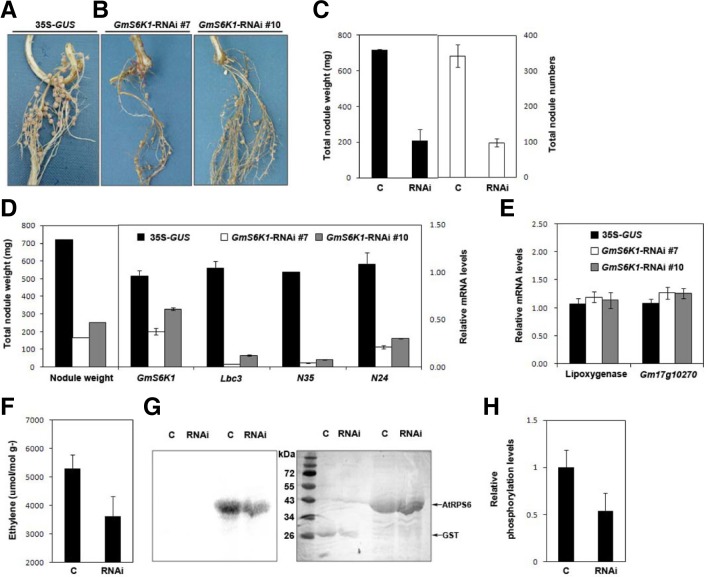Fig. 3.
Effects of the expression of an RNAi construct against GmS6K1 on nodule development. (A, B) Nodules formed on soybean hairy roots containing an empty vector containing 35S-GUS (A, control) or the GmS6K1-RNAi cloned in the vector (B). GUS-positive (transgenic) hairy roots with 35S-GUS or 35S-GUS-GmS6K1-RNAi were inoculated with B. japonicum (USDA110). GmS6K1-RNAi plant #7 showed severely impaired nodulation while GmS6K1-RNAi plant #10 had moderately affected nodules. These experiments were repeated three times and representative results are shown. In each experiment, 8 to 13 plants per construct were used. (C) Total nodule weights (mg) and total nodule numbers of control (C, 35S-GUS) and GmS6K1-RNAi (RNAi) plants were observed. (D) Relative transcript levels were examined for representative plants of different nodule weights. Transcript levels of GmS6K1, leghemoglobin (Lbc3), nodulin-35 (N35), nodulin-24 (N24), lipoxygenase and Gm17g10270 were measured by real time RT-PCR in controls (35S-GUS), GmS6K1-RNAi #7 and GmS6K1-RNAi #10 nodules. Ubiquitin was used as control. (F) Nitrogenase activities were determined by the acetylene reduction assay. Data are averaged from three independent experiments. (G) Kinase activity of GmS6K1 in nodules expressing 35S-GUS (C) or the GmS6K1-RNAi (RNAi). Left panel, autoradiograph of the kinase reactions with cellular proteins indicated. Right panel, Coomassie-stained gel of the reaction PAGE from which the autoradiograph shown in left panel was generated. (H) Quantification of the relative kinase activities shown in (G). Kinase activity was normalized to the activity with control nodules. Data were presented as the average and standard deviations (SD) of the means of three independent experiments.

